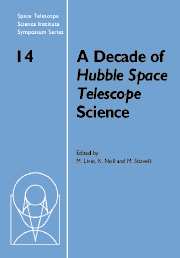Book contents
- Frontmatter
- Contents
- Participants
- Preface
- HST studies of Mars
- HST images of Jupiter's UV aurora
- Star formation
- SN1987A: The birth of a supernova remnant
- Globular clusters: The view from HST
- Ultraviolet absorption line studies of the Galactic interstellar medium with the Goddard High Resolution Spectrograph
- HST's view of the center of the Milky Way galaxy
- Stellar populations in dwarf galaxies: A review of the contribution of HST to our understanding of the nearby universe
- The formation of star clusters
- Starburst galaxies observed with the Hubble Space Telescope
- Supermassive black holes
- The HST Key Project to measure the Hubble Constant
- H0 from Type Ia supernovae
- Strong gravitational lensing: Cosmology from angles and redshifts
Starburst galaxies observed with the Hubble Space Telescope
Published online by Cambridge University Press: 13 August 2009
- Frontmatter
- Contents
- Participants
- Preface
- HST studies of Mars
- HST images of Jupiter's UV aurora
- Star formation
- SN1987A: The birth of a supernova remnant
- Globular clusters: The view from HST
- Ultraviolet absorption line studies of the Galactic interstellar medium with the Goddard High Resolution Spectrograph
- HST's view of the center of the Milky Way galaxy
- Stellar populations in dwarf galaxies: A review of the contribution of HST to our understanding of the nearby universe
- The formation of star clusters
- Starburst galaxies observed with the Hubble Space Telescope
- Supermassive black holes
- The HST Key Project to measure the Hubble Constant
- H0 from Type Ia supernovae
- Strong gravitational lensing: Cosmology from angles and redshifts
Summary
The contributions of the Hubble Space Telescope to our understanding of starburst galaxies are reviewed. Over the past decade, HST's imagers and spectrographs have returned highquality data from the far-ultraviolet to the near-infrared at unprecedented spatial resolution. A representative set of HST key observations is used to address several relevant issues: Where are starbursts found? What is their stellar content? How do they evolve with time? How do the stars and the interstellar medium interact? The review concludes with a list of science highlights and a forecast for the second decade.
Overview
Almost exactly 10 years ago ST ScI hosted its annual symposium entitled Massive Stars in Starbursts (Leitherer et al. 1991). Those were the weeks immediately prior to HST's launch, and the conference organizers felt it appropriate to have a meeting on the subject of starbursts because HST had the potential for significant contributions. Starbursts are compact (10°—103 pc), young (∼ 106—108 yr) sites of star formation, often with high dust obscuration. These properties make starbursts ideal targets for HST, given its superior spatial resolution, ultraviolet (UV) sensitivity, and (later-on) infrared (IR) capabilities.
As we all know, the high hopes were not immediately fulfilled, and it was not until after the First Servicing Mission that HST lived up to the expectations.
- Type
- Chapter
- Information
- A Decade of Hubble Space Telescope Science , pp. 179 - 197Publisher: Cambridge University PressPrint publication year: 2003
- 2
- Cited by

